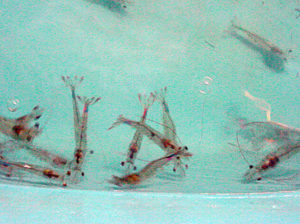Experiment conducted at Texas A&M University

Lipid levels for commercial shrimp feeds typically range 6 to 8 percent. It is recommended that they not exceed 10 percent because of decreased shrimp growth and increased mortalities, which are likely a result of nutrient imbalances or deficiencies related to energy and the toxic products of lipid oxidation.
Elevated dietary lipid levels affect the body composition of shrimp and can limit food consumption, ultimately resulting in nutrient deficiencies. However, increasing the digestible energy content of fish diets by lipid supplementation has in some cases shown a protein-sparing effect, with improvements in feed and protein utilization, as well as reduced nitrogen losses to the environment.
Studies with fish also have indicated that quantitative requirements for essential fatty acids (EFAs) increase with greater total dietary lipid, but this information is not known for shrimp.
Lipid levels tested
A recent six-week experiment at the Shrimp Mariculture Project of Texas A&M University in Port Aransas, Texas, USA, tested three dietary lipid levels (3, 6, and 9 percent of diet) and three levels (0.5, 1, and 2 percent of diet) of an omega-3 highly unsaturated fatty acid (HUFA) mixture. The mixture contained 416 mg eicosapentaenoic acid per gram and 237 mg docosahexaenoic acid per gram for a total of 778 mg total omega-3 fatty acids per gram.
Wheat starch, palmitic acid and stearic acid were adjusted to compensate for increasing dietary lipid and omega-3 HUFA levels. Litopenaeus vannamei postlarvae with a mean initial weight of 0.38 grams were stocked into 10, 32-liter replicate tanks/dietary treatment at a density of 4 shrimp per 0.09 square meter. The indoor recirculating water system with aeration was kept at a temperature of 30.0 degrees-C and salinity of 25.0 ppt.
Shrimp biological performance
A significant main effect of omega-3 HUFA on final weight was observed at the end of the trial. The final average weight of shrimp fed omega-3 HUFA at 0.5 percent of diet (4.77 grams) was not different from those fed 1 percent (4.46 grams), but was significantly higher than those fed 2 percent omega-3 HUFA (4.34 grams) (Table 1).
Gonzalez-Felix, Shrimp performance, Table 1
| Final Weight (g) | Instantaneous Growth Rate (% per day) | Survival (%) |
|---|
Final Weight (g) | Instantaneous Growth Rate (% per day) | Survival (%) | |
|---|---|---|---|
| Lipid level | |||
| 3% | 4.54 | 5.94 | 86.7 |
| 6% | 4.52 | 5.83 | 87.5 |
| 9% | 4.51 | 5.87 | 85.3 |
| HUFA level | |||
| 0.5% | 4.77a | 5.98 | 85.6 |
| 1.0% | 4.46ab | 5.77 | 87.2 |
| 2.0% | 4.34b | 5.88 | 86.7 |
Elevated dietary lipid content primarily affected lipid in shrimp tissues, resulting in significantly higher lipid in the hepatopancreas and muscle tissue of the shrimp. Nevertheless, shrimp growth showed no correspondence to total lipid deposition in tissues or the total level of any particular fatty acid.
Conclusion
This study failed to detect an increase in the quantitative EFA requirements of juvenile L. vannamei when increasing the supplementation level of dietary lipid. Results suggested that L. vannamei, omnivorous open-the-lycum shrimp, can satisfy their omega-3 HUFA requirements when supplied at 0.5 percent of diet, which is lower than the 1 percent level usually recommended for marine shrimp.
Depressed growth was observed in shrimp fed HUFAs at 2 percent of diet. The study also showed that increasing the dietary lipid level affected the lipid composition of shrimp by increasing lipid deposition in hepatopancreas and muscle tissue.
(Editor’s Note: This article was originally published in the August 2004 print edition of the Global Aquaculture Advocate.)
Now that you've finished reading the article ...
… we hope you’ll consider supporting our mission to document the evolution of the global aquaculture industry and share our vast network of contributors’ expansive knowledge every week.
By becoming a Global Seafood Alliance member, you’re ensuring that all of the pre-competitive work we do through member benefits, resources and events can continue. Individual membership costs just $50 a year. GSA individual and corporate members receive complimentary access to a series of GOAL virtual events beginning in April. Join now.
Not a GSA member? Join us.
Authors
-
Mayra Lizett González-Félix, Ph.D.
Departmento de Investigaciones Científicas y Tecnológicas
Universidad de Sonora
Rosales y Niños Héroes
s/n A. P. 1819 C. P. 83000
Hermosillo, Sonora, México -
Martin Perez-Velazquez, Ph.D.
Departmento de Investigaciones Científicas y Tecnológicas
Universidad de Sonora
Rosales y Niños Héroes
s/n A. P. 1819 C. P. 83000
Hermosillo, Sonora, México -
Delbert M. Gatlin III, Ph.D.
Department of Wildlife and Fisheries Sciences
Texas A&M University
College Station, Texas, USA -
Addison L. Lawrence, Ph.D.
Texas A&M University System
Shrimp Mariculture Project
Port Aransas, Texas, USA
Related Posts

Aquafeeds
A look at phospholipids in aquafeeds
Phospholipids are the major constituents of cell membranes and are vital to the normal function of every cell and organ. The inclusion of phospholipids in aquafeeds ensures increased growth, better survival and stress resistance, and prevention of skeletal deformities of larval and juvenile stages of fish and shellfish species.

Intelligence
‘Quality map’ for coho salmon fillets identifies color, lipid distribution
In research on coho salmon fillets, muscle astaxanthin level, color, and hardness generally increased from the anterior toward the caudal zone of the fish.

Health & Welfare
Effect of dietary salt on Nile tilapia
Study examines impact of an increase in dietary NaCl on nutritional and other physiological processes, and effects on gut microbiome in Nile tilapia.

Health & Welfare
Evaluating tilapia processing silage in Pacific white shrimp diets
Study evaluates growth of Pacific white shrimp in various conditions and fed diets with different inclusion levels of tilapia processing waste silage.


